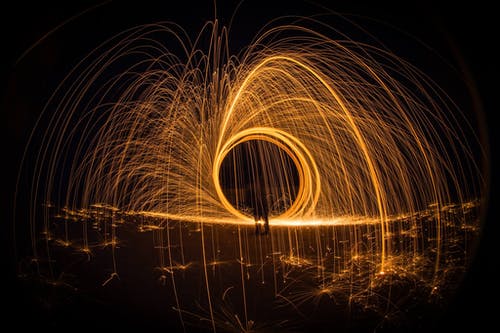Do you know what light painting is? Have you been wanting to try this photography technique for a long time, but don’t know how to do it with your SLR? As always, Cash Converters invites you and helps, to know a little more, developing new skills within your hobby or, simply, because you are curious.
Photography and, specifically, light painting, also known as physiogram, is one of the most beautiful and rewarding hobbies that you can find today. Being able to capture ideas, people, and their thoughts in an image, and even redefining concepts, brings us closer to the great artists of painting or sculpture in a way, perhaps, simpler and just as beautiful.
What is light painting?
It is one of the most striking techniques in the world of photography and it is very fashionable today. Despite being among current trends, this process was first carried out in 1914 by Frank Gilbreth and his wife Lillian Moller Gilbreth and has been used by great artists such as our beloved Pablo Picasso.
This photographic technique is based on drawing with a light directly on the photograph, making all kinds of lines, shapes, or whatever your imagination and your skills allow you, always shooting at very, very slow shutter speeds and using air as a frame.
If this type of photography is characterized by something, it is by the drama it can bring to any scene that we want to reflect. While it is true that we should not limit our imagination when capturing moments, the gloomy, macabre, and sepulchral tone contrasts perfectly with the brightness and lights that are created with light painting.
I have an SLR, can I do it with this type of camera?
Basically, what you need to start working with light painting in photos is to put your imagination and patience to work, a lot of patience. Don’t worry, don’t get down if you’re one of those who easily lose your nerves, because painting with light is easy. However, we must practice a lot until we get the hang of it and be real magicians.
What aspects should we take into account?
Before starting to work and practice with photography and lights, we are going to introduce ourselves to the subject with a series of aspects that we must know beforehand and that will help us understand and facilitate our start-up:
Lighting: Darkness will be the main factor in light painting photographs, although to capture the entire scene the use of the flash may be necessary and recurrent.
Models: The use of models can give our photographs a plus, either by customizing their clothes or with a little makeup.
Long exposures: When talking about long exposures, we refer to the time from when we begin to capture the photograph until it is finished taking and that can take up to minutes. Hence we mentioned patience.
Photographer: It is not necessary to be a great expert in the field, with the notions that we explain a little below it will be enough. What we want to highlight are the two options it has: remote control to launch the captures or another person to help press the camera button if we do not have the remote control.
Movements: Imagination and practice, trying things out to see how the photographs turn out. Do not cut yourself and start moving your whole body.
Material: a camera and little else Indeed, little material is needed to paint with light on photographs. Light painting with SLR will not make you spend large amounts of money on media that may end up catching dust when fashion passes or you change your hobby:
Remote trigger: One of those camera accessories that every good lover of light painting must-have. At a very cheap price, you can find triggers that allow you, by pressing a single button, to capture photographs from a distance and you will not need to have an assistant or set a timer. You can find three types:
- With cable, the remote is connected to the camera, and pressing the button takes the picture.
- Wireless, through infrared rays, connects the camera with the remote to capture the moment.
- With cable and intervalometer, in addition to having the function of the cable shutter, through a screen you can program your SLR so that the shots take place in intervals.
Tripod: To keep the camera and lens stable during long shooting exposures, a tripod is an essential accessory.
Light sources: What will be the objects that will generate the drawings in your photograph. From your own mobile to fluorescent tubes, flares, and fireworks (beware of burning) will serve this purpose.
Colored gels: That will give life to your light painting. It will create the contrast between the brightness of the gels and the darkness of the environment.
Small guide to configuring your SLR for light painting
Anyone can understand it, even we have been able to make a light painting with Reflex with these indications. Now, configuring your camera will be much easier:
Manual mode: Control all the parameters of your camera in this way.
ISO: You must lower it as much as possible since by setting it to the minimum we will avoid all possible noise.
Diaphragm aperture: It will depend on what type of scene we want to capture since a dark environment where we seek to see what we only draw is not the same as a natural area in which we intend to see the different elements that appear in it. Therefore, placing it at f / 8 would be the most appropriate and from there to experiment.
White balance: It serves to give more or less warmth to the photo, although if you exceed it, it can be unnatural. Here you will have the freedom to play.
Exposure times: With manual mode, you can control this parameter and adapt it to what you are looking for. We recommend using slow speeds, above 30 seconds if you deem it necessary.
Focus: You can place an object in the area where you will make the light painting and block the frame there so that when taking the photo it does not appear blurred. It is important to do this as the camera, being in manual mode, will not do it by itself.
Photo format: Working with RAW will allow you to have a wider margin of exposure correction when editing it.
Light painting, step by step
Choose a site: Focus well on what you are looking for with the photo and choose, from there, the perfect location. Do not forget that the darker the darkness, the greater the contrast you will achieve with light painting.
Fine-tune your camera: As we have seen before, the configuration of the camera parameters must be optimal for this type of technique, so make sure that you have followed the instructions we have given you.
Focus: Do not forget to focus on the point or place on which you are going to make the painting with light. You don’t want the image to appear blurred …
Start painting: Point the light objects towards the camera so that the results are the desired ones and start drawing, let the art flow.
Presume: Show your work to the world and leave all impressed with your new photographic skill.
You already have all the details, now it’s your turn to work on light painting. So turn off the lights, turn on the camera and let all your art come out.

